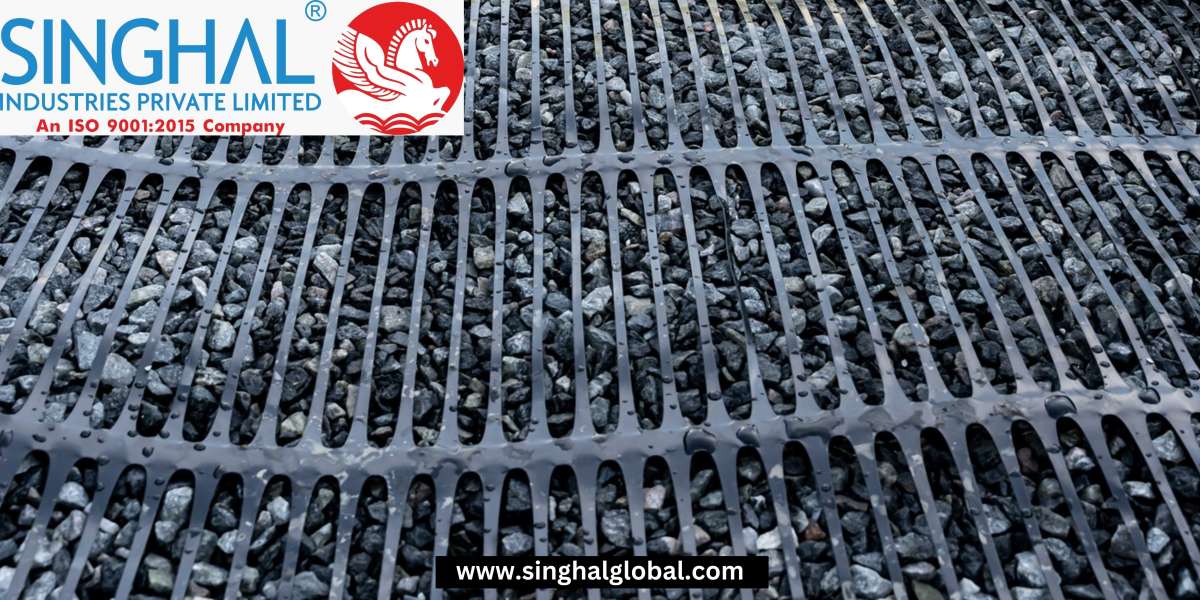Uniaxial geogrids are crucial materials used for improving soil strength and stability in various construction and engineering projects. Whether it's roads, retaining walls, or embankments, the use of Hdpe uniaxial geogrid ensures better performance and longer-lasting structures. In this blog, we will explore the benefits, applications, and properties of uniaxial geogrids, particularly focusing on HDPE uniaxial geogrid and its role in soil reinforcement.
What is Uniaxial Geogrid?
Definition of Uniaxial Geogrid
A uniaxial geogrid is a geosynthetic material designed to reinforce soil by providing tensile strength in one direction. Its high tensile properties help resist the pressures exerted on the soil, making it ideal for supporting structures like retaining walls, embankments, and slopes. Unlike biaxial geogrids, which provide strength in two directions, uniaxial geogrids are optimized for use where forces are exerted predominantly in one direction, such as in long stretches of road or embankments.
Difference Between Uniaxial and Biaxial Geogrids
While both uniaxial and biaxial geogrids are used for soil reinforcement, they differ in their load-bearing capabilities. Biaxial geogrids provide tensile strength in both the longitudinal and transverse directions, making them suitable for stabilizing subgrades beneath roads and pavements. In contrast, uniaxial geogrids are specifically designed to handle loads in one direction, making them more efficient for reinforcing walls, embankments, and steep slopes.
Applications of Uniaxial Geogrid in Construction
How Uniaxial Geogrid Works in Soil Reinforcement
Uniaxial geogrids provide reinforcement by distributing loads across a broader area, preventing localized failures. By confining the soil, they reduce lateral movement, enhancing the overall stability of the structure. These geogrids are used to reinforce the foundation of roads, highways, and other infrastructure projects where soil strength is paramount.
Use of Uniaxial Geogrid in Roads and Highways
In road construction, uniaxial geogrids are installed beneath the road surface to stabilize the soil. They help prevent the road from sinking or deforming under heavy traffic loads, ensuring long-term durability. The use of uniaxial geogrids also reduces the need for frequent maintenance, lowering the overall cost of infrastructure projects.
The Role of Uniaxial Geogrid in Retaining Walls
Retaining walls face constant pressure from the soil behind them, and without proper reinforcement, they can collapse under the weight. Uniaxial geogrids are often installed behind retaining walls to distribute the load evenly, reducing stress on the wall and preventing structural failure.
Benefits of Using Uniaxial Geogrids
Improved Load-Bearing Capacity
One of the most significant advantages of using uniaxial geogrids is their ability to improve the load-bearing capacity of the soil. By reinforcing the soil, they enhance its ability to support heavy loads, making them indispensable in the construction of bridges, embankments, and retaining walls.
Long-Term Durability and Stability
Uniaxial geogrids are designed to withstand environmental stresses such as moisture, temperature changes, and soil chemical reactions. Their long-term durability ensures that structures remain stable over time, reducing the risk of failure and the need for costly repairs.
Cost-Effectiveness and Resource Efficiency
While the initial cost of installing uniaxial geogrids may seem high, their ability to reduce maintenance costs and extend the lifespan of infrastructure projects makes them a cost-effective solution. Additionally, by reducing the amount of construction material required, they contribute to resource efficiency.
Understanding HDPE Uniaxial Geogrids
What Makes HDPE Uniaxial Geogrids Unique?
HDPE uniaxial geogrids are known for their high tensile strength, flexibility, and resistance to chemical and biological degradation. Unlike other materials, HDPE can withstand harsh environmental conditions, making it a popular choice for long-term soil reinforcement projects.
Advantages of HDPE Material in Uniaxial Geogrids
The use of HDPE in uniaxial geogrids offers several benefits, including resistance to ultraviolet (UV) radiation, chemicals, and moisture. HDPE uniaxial geogrids are also lightweight, making them easy to transport and install. These qualities make HDPE geogrids an ideal solution for reinforcing retaining walls, slopes, and embankments.
Uniaxial Geogrids for Soil Reinforcement
Enhancing Soil Performance with Uniaxial Geogrids
The primary function of uniaxial geogrids is to improve the mechanical properties of the soil, particularly in projects where the soil needs reinforcement to carry heavy loads. By providing tensile reinforcement, these grids reduce soil displacement, limit erosion, and increase the overall strength of the ground structure. This enhancement helps in maintaining the integrity of the foundation, ensuring the longevity of the construction.
Applications of Uniaxial Geogrid in Embankment and Slope Reinforcement
Uniaxial geogrids are especially beneficial in embankment and slope reinforcement. In areas prone to landslides or erosion, the geogrid acts as a support system, preventing soil displacement and maintaining slope stability. Uniaxial Geogrid India are strategically placed to manage the distribution of stress across the embankment or slope, ensuring that the soil holds its shape and structure even under extreme conditions.
Uniaxial Geogrids for Bridge Abutments and Load Distribution
For bridge abutments, uniaxial geogrids help distribute the load of the bridge evenly across the soil. This reduces the risk of soil settling or failure, which can lead to structural issues. By enhancing the load distribution, uniaxial geogrids not only reinforce the bridge foundation but also contribute to safer and more reliable infrastructure.
Environmental Impact of Uniaxial Geogrids
Sustainability of Using HDPE Uniaxial Geogrids
Sustainability is an increasingly important consideration in construction, and uniaxial geogrids contribute positively to this aspect. HDPE (High-Density Polyethylene) uniaxial geogrids are durable and resistant to environmental degradation, meaning they last longer and reduce the need for frequent replacements. This longevity reduces the overall environmental impact of construction projects by minimizing waste and the need for additional resources.
Reducing Environmental Footprint with Soil Reinforcement Solutions
By reinforcing soil and reducing the need for extensive excavation or the use of additional construction materials, uniaxial geogrids help minimize the environmental footprint of projects. These grids reduce the need for raw materials such as concrete or steel, which typically have higher carbon footprints. Additionally, the extended lifespan of geogrid-reinforced structures means fewer interventions over time, contributing to lower environmental impact.
Choosing the Right Uniaxial Geogrid for Your Project
Factors to Consider When Selecting Uniaxial Geogrid
Choosing the right uniaxial geogrid for a project depends on several factors, including the type of soil, the load-bearing requirements, and the environmental conditions. It's essential to assess the tensile strength required for the project, as well as the long-term durability of the geogrid in specific environmental conditions, such as exposure to moisture or chemicals.
Performance Characteristics to Look For
When selecting a uniaxial geogrid, consider the following performance characteristics: tensile strength, flexibility, resistance to environmental factors (such as UV radiation and chemicals), and ease of installation. These factors will determine the overall effectiveness of the geogrid in reinforcing the soil and supporting the structure.
Installation Process of Uniaxial Geogrid
Step-by-Step Guide to Installing Uniaxial Geogrids
Site Preparation: Clear and level the ground where the geogrid will be installed. Ensure that the surface is free of debris and large rocks.
Geogrid Layout: Roll out the uniaxial geogrid in the required direction, ensuring proper alignment. Since uniaxial geogrids provide strength in one direction, make sure that the grid is laid according to the load-bearing requirements of the project.
Anchoring: Secure the geogrid at the edges using suitable anchoring techniques. This ensures that the grid remains in place during the backfill process.
Backfilling: Carefully backfill the area with soil, ensuring that the material is compacted evenly. The geogrid should be covered adequately, with no sharp objects or rocks that could damage the grid.
Final Inspection: After installation, inspect the geogrid and the soil structure to ensure proper placement and stability.
Tools and Equipment Required for Installation
To install uniaxial geogrids, you will need basic tools such as shovels, rakes, and compacting equipment. For larger projects, heavy machinery like bulldozers and rollers may be necessary to ensure efficient soil compaction and geogrid placement.
Case Studies: Successful Projects Using Uniaxial Geogrid
Reinforcing a Retaining Wall in Urban Areas
In a metropolitan construction project, uniaxial geogrids were used to reinforce a retaining wall along a highway. The geogrids helped maintain the integrity of the wall by evenly distributing the load and preventing soil erosion. As a result, the wall remained stable despite high traffic loads and adverse weather conditions.
Strengthening Slopes in Landslide-Prone Zones
In a mountainous region prone to landslides, uniaxial geogrids were employed to stabilize slopes and prevent soil displacement. The grids were laid out along the slopes, providing reinforcement that minimized soil movement during heavy rains, reducing the risk of landslides and protecting nearby infrastructure.
Common Challenges and Solutions in Using Uniaxial Geogrids
Overcoming Installation Issues
One common challenge during the installation of uniaxial geogrids is ensuring proper alignment and anchoring. If the grid is not laid correctly, it can lose its effectiveness. To overcome this, careful planning and the use of appropriate anchoring techniques are essential. Proper site preparation is also critical in avoiding issues during the installation process.
Addressing Load-Bearing Failures with Uniaxial Geogrids
In cases where the soil structure fails to bear the required load, uniaxial geogrids can help distribute the pressure more evenly. However, if load-bearing failures still occur, it may be necessary to reassess the type of geogrid used or reinforce the grid with additional layers. Consulting with a geotechnical engineer can help resolve these issues.
Uniaxial Geogrids vs Other Soil Reinforcement Methods
Comparing Geogrids with Geotextiles and Geocells
While geogrids are excellent for providing tensile reinforcement, geotextiles and geocells offer different benefits. Geotextiles, for instance, provide filtration and separation properties, making them ideal for drainage applications. Geocells, on the other hand, are used to create a honeycomb structure that stabilizes the soil and prevents erosion. Each solution has its strengths, but for load-bearing reinforcement, uniaxial geogrids often outperform the alternatives.
Why Choose Uniaxial Geogrids for High-Stress Applications?
For projects where soil reinforcement is crucial, such as in retaining walls, embankments, or bridge abutments, Uniaxial Geogrid for Soil Reinforcement provide superior performance. Their ability to handle high loads in one direction makes them the ideal choice for high-stress applications where other solutions may fall short.
Future of Uniaxial Geogrids in Infrastructure
Innovations in Geogrid Technology
The future of uniaxial geogrids looks promising, with ongoing innovations aimed at improving their strength, flexibility, and environmental sustainability. Research is focused on developing new materials that enhance the performance of geogrids in extreme conditions, making them even more versatile for a range of applications.
Expanding Applications in Global Infrastructure Projects
As global infrastructure projects continue to grow, the demand for reliable soil reinforcement solutions like uniaxial geogrids is expected to increase. From road construction to bridge abutments and slope stabilization, the role of uniaxial geogrids in improving soil performance and infrastructure longevity will only become more significant.
FAQs about Uniaxial Geogrids
What is the difference between HDPE uniaxial geogrids and other geogrid materials?
HDPE uniaxial geogrids are known for their superior resistance to environmental factors such as UV radiation, chemicals, and moisture. They offer higher tensile strength compared to other materials, making them ideal for long-term projects.
How do uniaxial geogrids enhance soil reinforcement?
Uniaxial geogrids improve soil reinforcement by providing tensile strength in one direction, preventing soil displacement and distributing loads evenly across the soil structure.
Can uniaxial geogrids be used in slope stabilization?
Yes, uniaxial geogrids are commonly used in slope stabilization projects, where they reinforce the soil and prevent erosion or landslides, especially in areas prone to environmental challenges.
What are the benefits of using HDPE uniaxial geogrids in retaining walls?
HDPE uniaxial geogrids provide excellent tensile reinforcement, helping to distribute the load behind retaining walls and prevent structural failure due to soil pressure.











